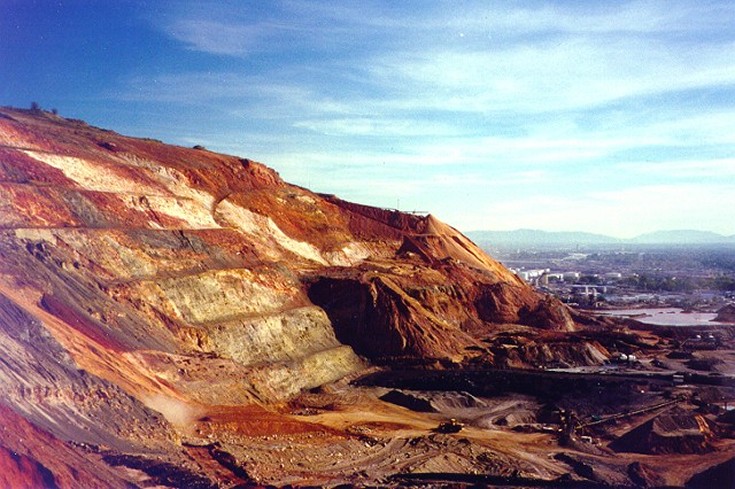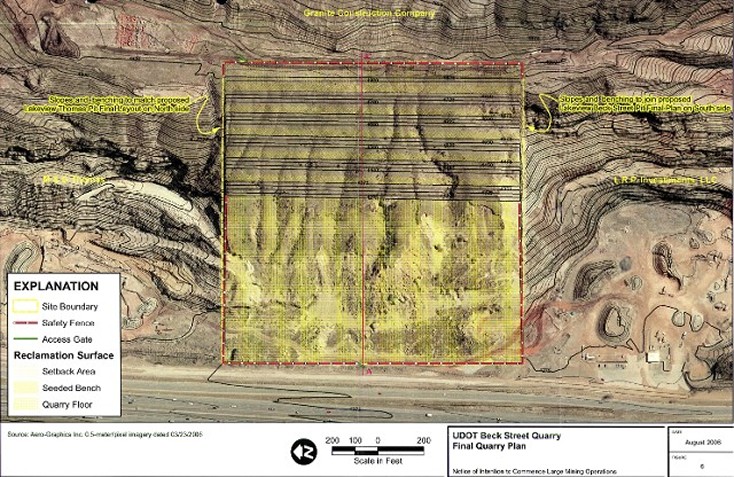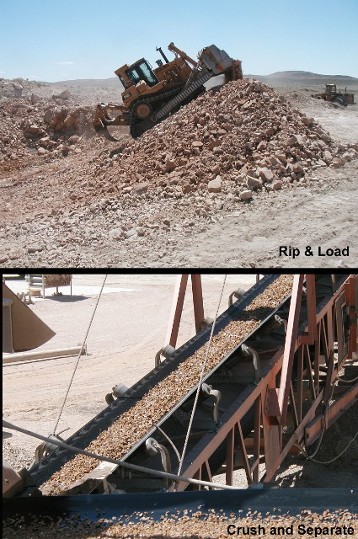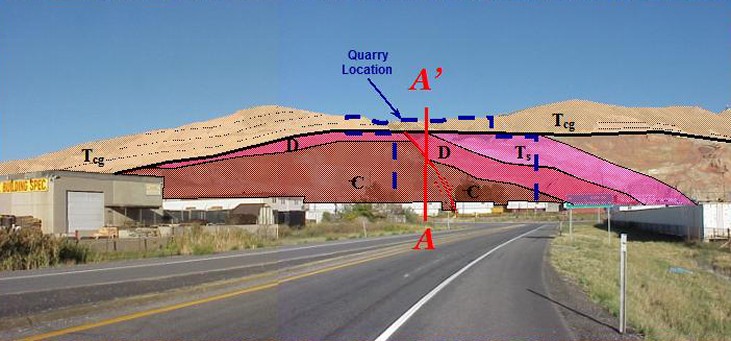Materials/Source Investigations

Staker & Parson aggregate highwall, Beck Street, Salt Lake City, Utah |

Mine plan, UDOT Beck Street Quarry, Davis County, Utah
|
Utah Division Of Oil Gas and Mining (DOGM) Large Mining
Operation Permitting, Beck Street Quarry, City of North Salt Lake, Utah -
Project Geologist, 2006. Prepared permitting for a Large Mining
Operation regulated by the State of Utah DOGM for an aggregate rock Quarry that
was to be used for materials for the construction of the Legacy Highway in
northern Utah. The permit application
required the development a mine operations and reclamation plans for mine
development, operations and closure. Development and operations plans required
the description of equipment used, routing of haul trucks, blasting patterns
and estimates to be used on the site.
The reclamation plans required descriptions of topsoil management and
sequestering, design and stability analysis of final mine cut highwall, and
final re-contouring and revegetation of the site, and an estimate of surety to
be bonded for the mine reclamation costs. |

Bulk aggregate sampling and crushing, Dugway Proving Ground, Utah |
Michael Army
Airfield Reconstruction Phase II, Aggregate Investigation, Dugway Proving -
Project Geologist, 2002.
Aggregate Source Investigation for Proposed US Army 15,000-foot Fixed
Wing Runway, Dugway Proving Grounds.
Investigated numerous aggregate source locations at the proving grounds
to identify source locations with adequate aggregate resource volumes for the
construction of a 15,000-foot fixed wing runway. Eight sites were initially
considered for resource development with two sites selected for resource volume
and material quality exploration. Ultimately 1.2-million tons of suitable
materials were identified to satisfy the 0.75-ton product requirement for the
runway construction.
Michael
Army Airfield Reconstruction Phase III, Aggregate Investigation, Dugway Proving
Ground, Utah - Project Geologist, 2002 to 2005. The reconstruction of the Michael Army Airfield at
Dugway Proving Ground, Utah required the development of new aggregate sources
on the Proving Ground that could provide 1.25 million tons of aggregate for the
reconstruction of two aircraft runways, 8,000 and 15,000 feet long. The 8,000-
foot runway was to serve as an interim asphalt runway during the reconstruction
of the 15,000-foot Portland concrete (PCC) main runway. During 2002 preliminary aggregate source
evaluations for the 8,000-foot asphalt runway, which was constructed in 2003,
the two aggregate source areas used were found to be lacking in suitable sand
and gravel gradations, or to be comprised of lithologies unsuitable for the PCC
materials that would eventually be needed for the main runway scheduled for
construction in 2005. To locate adequate materials for the PCC runway
requirements a geological and geomorphological GIS database was constructed by
integrating existing geological mapping and geomorphological models relating to
Pleistocene Lake Bonneville hydrography. The GIS helped to identify 10 candidate
sand and gravel and rock aggregate sites on the Proving Ground that were later
explored, sampled and tested for the runway PCC requirements. Despite the Proving Ground being nearly as
large in area as Rhode Island, only a limited area was found to possess
suitable lithologies for the PCC runway requirements. The GIS was also used to
prioritize the selected sites for final selection of two sites on the basis of
material suitability criteria, site access, proximity to the runway, and
available water source locations. |

Oblique image Staker & Parson aggregate highwall with geological interpretation overlay, Beck Street, Salt Lake City, Utah
|
Geologic Materials
Assessment Staker Paving Beck Street Quarry, Approximately 2100 North Beck
Street, Salt Lake City, Utah - Project Manager,2000. Study was conducted to assess the nature and
distribution of geologic-materials at the site. This assessment evaluated the
distribution of competent Paleozoic rocks as opposed to the softer Tertiary and
Quaternary rocks, for the development of a mining plan at the Beck Street
Quarry.
Reclamation Highwall
Evaluation, Staker and Hughes Quarries, approximately 2100 North Beck Street,
Salt Lake City, Utah - Project Manager, 1995. The study was conducted to
evaluate the geological conditions affecting the long-term-future stability of
adjacently owned coarse aggregate quarries. The geology of the sites and
critical rock structure data were mapped in the field and static and dynamic
slope stability analyses were modeled for differing slope angle/benching
scenarios. Final slope configurations were recommended for closure and
reclamation planning. |
|

